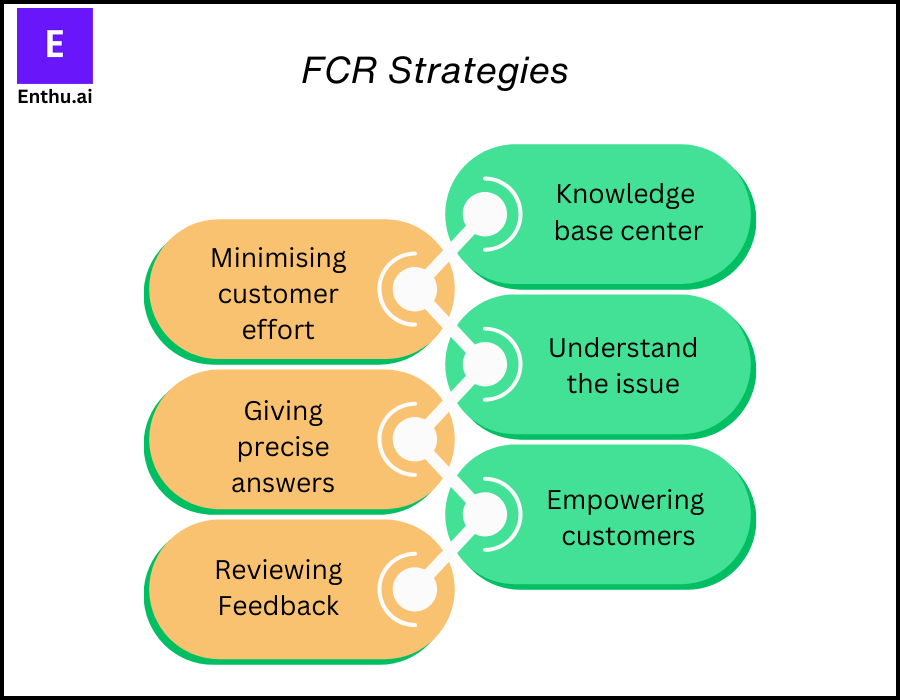First Call Resolution, or FCR, is a practice in call centers that strives to answer the phone and resolve your issue while you are still on the first call.
In a high-quality call center environment, this means that after the first call you make where you – or your sales representative – speak to a support person, you have had your problem resolved.
Meaning there should be no need for follow-up calls because the problem is clearly understood by both parties and the appropriate solutions have been implemented.
Table of Contents
A. What is First Call Resolution (FCR)?

First call resolution is the call center’s ability to solve customer issues within the first call itself, with no-follow up required.
FCR is a great way to know about customer satisfaction because the higher the FCR rate, the more satisfied are the customers. Also, this metric helps you measure the agent’s efficiency.
As per the SQM group, 86% of customers feel that issues should be solved within the first call itself.
B. What is a Good FCR Rate?
When we talk about industry standards of FCR, it usually comes to 65-75%. A recent study showed that the average FCR rate around the world is 74%.
You’d think that an FCR rate of 75% or above is reasonable.
But don’t forget that this is the average rate, and it takes into consideration FCR rates of 41% to 94%.
It can be concluded from these numbers that an FCR rate of 90% is considered good.
C. First Call Resolution Rate Calculation
First Call Resolution formula can be measured as a comparison between the calls received and the calls on which the queries of the customer were resolved in the first interaction.
There are two ways of measuring the FCR rate – external and internal.
1. External FCR
External FCR measurement is a reliable tool. It measures the First Call Resolution Rate.
This method depends on the opinion of the customers who call to get their issues resolved. The information is collected with the help of a survey.
At the end of a call, the customer is asked whether the issue was resolved or not.
You can do this by sending a post-contact email or using IVR. The agent, too, can directly ask the customer. Or, there might be a poll at the end of a chat.
External first call resolution formula:

If you receive 200 calls on day 1 and 160 customers say their queries have been solved, the FCR rate will be (160/200)x100=80%.
2. Internal FCR
Internal FCR measurement does not follow industry standards.
Every company has its own way to define FCR and its standard for it. It can be an insightful way of analyzing the performance of the contact center.
It can also help set goals for the agents to achieve higher FCR rates.
Common ways to measure FCR include:
- QA call monitoring
- CRM
- ACD
- Repeat call technology
- Conversation intelligence software
These are used to measure whether a customer calls back with the same issue within a specific period. This is called the callback time, and the company has to decide what it will be.
Internal first call resolution formula is:

- Imagine receiving 200 calls, out of which 180 are from first-time callers.
- Your internal tools determine that 120 queries have been resolved as there was no return call within the determined callback time of, say, two days.
- Your FCR rate is (120/180)x100=66.67%.
Tips on Internal First Call Resolution Rate Calculation
- Internal first call resolutions are based on the absence of repeat calls. This may not be a foolproof way to determine whether the issue was resolved or if the customer decided to give up and end the call.
- It is easy to manipulate this data and metrics used for internal calculations. It depends on the method of data collection, qualifying window, the definition of repeat calls, scope, callback time, etc. All of these are subjective
D. Why is First Call Resolution important?

1. Helps to retain customers
Quickly solving customer issues on the first call will keep them loyal to your business.
Because customers expect a quick resolution to their problems as they don’t want to spend a lot of time on the call.
Also, 67% of customers list poor customer service as the reason to choose another product.
So, make sure to solve issues effectively and efficiently.
2. Change the mindset of dissatisfied customers
If you can quickly solve their problems, unhappy customers will become loyal.
If a customer is unhappy with a product, they get excellent service. This will help reduce any frustration they have with the business.
3. More productive customer service
When agents solve customer issues on the first call, it eliminates repeat calls.
As a result, agents can take other calls due to the short wait time. This leads to productive, efficient customer service.
4. Drives revenue
When a customer is happy with the customer service, they are likely to spend 17% more just because of customer service.
So, always aim to solve customer issues the first time they contact you.
5. Decrease contact center costs
Acquiring a new customer is more expensive than retaining an existing one.
So, focus on giving great customer service to your current customers. This helps reduce contact center costs through FCR.
E. First Call Resolution Best Practices

1. Eliminate wait
Businesses need to be quick to solve customer issues because, for customers, time is of utmost importance
Therefore, it becomes essential for customer service to quickly respond to issues raised by customers.
One way to do that is by having a self-service portal. A self-service portal gives customers the power to resolve their own issues without waiting for a call center agent to respond.
It also helps agents to handle more complex issues and saves the cost of hiring new agents for businesses.
If a customer still wants to talk to agents, they will be ready to handle calls and improve first-call resolution.
2. Document answers to common problems
If different customers are asking similar kinds of questions on a regular basis, then it is better to have a knowledge base or FAQ section.
Having an FAQ section will serve as a library in which answers to common questions about the product or service will be there.
Customers can check out this section and solve their issues on their own without the need to contact the agent.
And if customers contact the agent, then agents can direct them to these resources which results in stronger FCR.
3. Gather as much information as possible
Agents should gather as much information as they can about the customers and their issues before and during the call.
When agents are well-informed, there is a high chance they can solve issues within the first call itself.
Businesses must invest in CRM solutions. They should hold valuable customer data, including service history. Another thing is that agents should be trained to listen to customers and ask the right questions to understand the issue completely.
Once agents understand the issue, they will resolve it quickly and there will be no need for another call from the customer.
4. Provide clear instructions whenever possible
Once agents and customers agree on the issue, agents must be clear and concise with customers about the required action.
If the action is to be taken by agents, then they need to tell customers what they will be doing and when they can expect a resolution.
And if action is to be taken by the customer, then agents need to clearly define the steps that customers have to take to resolve the issue.
But if the response is not clear enough, then there will be a follow-up call to get an accurate response.
5. Ask if there is anything else
You must end the call after the customer is satisfied with the solution. But before you end the call, it is best for an agent to ask the following questions:
By asking these questions, you are reconfirming whether the given solution works or not for the customer.
Once the customer confirms the solution works, it will be your first and last call with them about that issue.
6. Regularly re-evaluate your methods
You need to continuously monitor and improve your existing methods if you want to improve first call resolution rates.
To start with, you must know the strengths and weaknesses of agents who are responsible for handling customer issues.
You need to review the agent’s interactions with the customers and give them feedback on what went well, where they can improve, and how can we reduce call center attrition, and How Predictions Based on Call Center Statistics Optimize Customer Support. etc.
To keep a check on agents, you can use conversation intelligence software like Enthu.AI that monitors, and analyzes all the calls of the agents and tell you the calls which have issues.
In addition to this, you need to evaluate feedback received from customers and understand what went well and what didn’t and build brand sentiment.
Based on this, you can update internal methods to make it more efficient.
F. First Call Resolution Benefits

Is it necessary to resolve a problem on the first call? Isn’t it enough if you can just manage to solve a problem – irrespective of how many calls have been needed to do so?
You see, FCR indicates immediate problem solving and excellent customer care.
Post-sales services are an excellent quality when potential customers consider your company.
1. Customer Satisfaction
Problems while using a product or service are a reason for customers to be upset. If the problem persists, it’s all the more reason for them to feel frustrated!
On the contrary, when you resolve the issue on the first call itself, it improves customer satisfaction.
FCR rate is directly related to customer satisfaction, with a 1% increase in FCR leading to a 1% rise in the CSAT score!
2. Sales Opportunities
With more problems resolved in the first attempt through a fruitful conversation and improved customer satisfaction, you help change their perception of your company.
Satisfying post-sales customer care services can encourage the customer to make more purchases for your company and increases NPS score.
If you can manage to address your customer’s concerns and handle them in a single call, they will be more open to accepting cross-selling pitches.
They might also recommend you to their friends and family, increasing your overall sales.
3. Customer Churn
A frustrating issue for customers is waiting to get their concerns resolved in follow-up calls. They would prefer their problems to be solved in the first call.
When their expectations are not met, it will lead to a loss of the customer. They will start defecting to your competitors.
This shifted loyalty is called customer churn, which can be reduced with FCR.
4. Operational Costs
FCR can help bring down the volume of repeat or follow-up calls. Hence, this allows the agents to focus on other customer-centric tasks.
It also prevents the time and cost invested in reworking on the same issue.
Let’s take an example to understand this.
Imagine that your company has 100 agents working for 20 days a month. Each of them handles 100 calls a day and has an FCR rate of 75%. The cost for each call is $5.This leads to an operational cost of $50,000 per day. Since the FCP rate is 75%, the company loses $12,500 a day because of unresolved issues, i.e., $250,000 a month. A mere increase of 1% in FCR can help the company save $10,000 a month.
G. First Call Resolution Strategies

To improve First Call Resolution, you can implement the following strategies:
1. Creating Knowledge Base Center
A knowledge base center should offer information about the product/service and have the answers to frequently asked questions.
Customers should find their answers by reading an article. Simply sharing the link should help resolve a problem for FCR.
2. Minimising Customer Effort to Reach Agent
Customers shouldn’t need to jump through hoops to reach an agent for help.
It should be a fast and easy process so that they can clearly express their problem on the call instead of expressing their frustration.
This will allow you to resolve the issue in one call.
3. Understanding the Issue
In order for you to give the perfect solution, you must understand the question first.
Be empathetic and ask questions and gather information. Don’t forget to ask the customer to confirm whether you have understood the situation correctly – and avoid assumptions.
4. Giving Precise Answers
Avoid giving complex solutions to your customers. It can confuse them.
The only assumption for you to make is that your customer doesn’t know anything at all. So don’t leave anything for them to interpret. Be clear and use simple words.
5. Empowering Customers
While resolving issues, your aim should be to equip the customer with the knowledge to use the product/service without facing problems in the future.
You can always ask customers if they would be interested in learning more and share the knowledge base.
6. Answering all Questions
During the conversation, note down all your customer’s questions and address each of them one by one.
Don’t disconnect without making sure that if the customer has other related questions, those get answered too on the same call to prevent follow-ups.
7. Reviewing Feedback
It is essential to review the different support channels like calls, chat, email, etc., on a regular basis.
This will help you understand what common problems are bothering your customers. Also, go through the reviews to understand what improvements they want.
H. Example of improved First Call Resolution

Let’s consider a few examples of First Call Resolution and how they may help.
Imagine that a customer calls you to tell you that they are unable to use the app that your company provides.
From the conversation that follows, you realize that they have not used the same email id to register and log in.
They try using the same email id and succeed in logging in and using the app.
This means that you manage to resolve their problem in a single call, without escalation or follow-up calls.
That’s a First Call Resolution, giving you a 100% FCR rate.
However, it is possible for you to end up taking the second or third call with a customer after another agent fails to resolve the problem in the first call.
It might not necessarily be possible for you to resolve the problem in this call, which can hamper your FCR rate through no fault of your own.
To improve FCR, you need to measure and analyze your current performance first. A great example of a tool to get started with the improvement process is speech analytics.
It captures entire conversations and incorporates caller identifiers with speech.
This helps to identify repeat calls with a particular agent and understand the correlation with issues and products.
This way, it is easier to figure out the reason behind the repetition of a call from a contact regarding the same issue – and address the underlying problem.
Call centers using speech analytics have a higher FCR rate compared to those that do not.
Improving FCR mean
- Eliminating wait time.
- Providing clear instructions
- Gather information
- Answers to common problems
- Teaching the customer by offering information for future use.
- Verifying whether you have resolved the problem
Conclusion
First Call Resolution is an important call center metric for understanding customer satisfaction.
By looking at this metric, you would understand whether customers are happy with the customer service or not.
Also, it is a great way to know how efficiently, agents are working. If agents are efficient, then you can see high first-call resolution rates.
Improvement in FCR is directly related to low costs, high customer satisfaction, and increased profits.
Therefore, it is important that solve customer issues within the first call itself, without arising the need for repeat calls.
FAQs
What is First call resolution?
First call resolution (FCR) is a metric used to measure customer service effectiveness. It refers to the percentage of customer inquiries or issues that are resolved during the first interaction with a representative.
How do I resolve FCR?
To improve first call resolution, ensure representatives have proper training, access to information, and the ability to escalate issues if needed. Analyze call data to identify common issues and areas for improvement.
Why is first call resolution important?
First call resolution is important because it leads to higher customer satisfaction, reduces call center costs, increases efficiency, and improves overall customer experience. It also helps to build customer loyalty and can positively impact business growth.




 On this page
On this page


